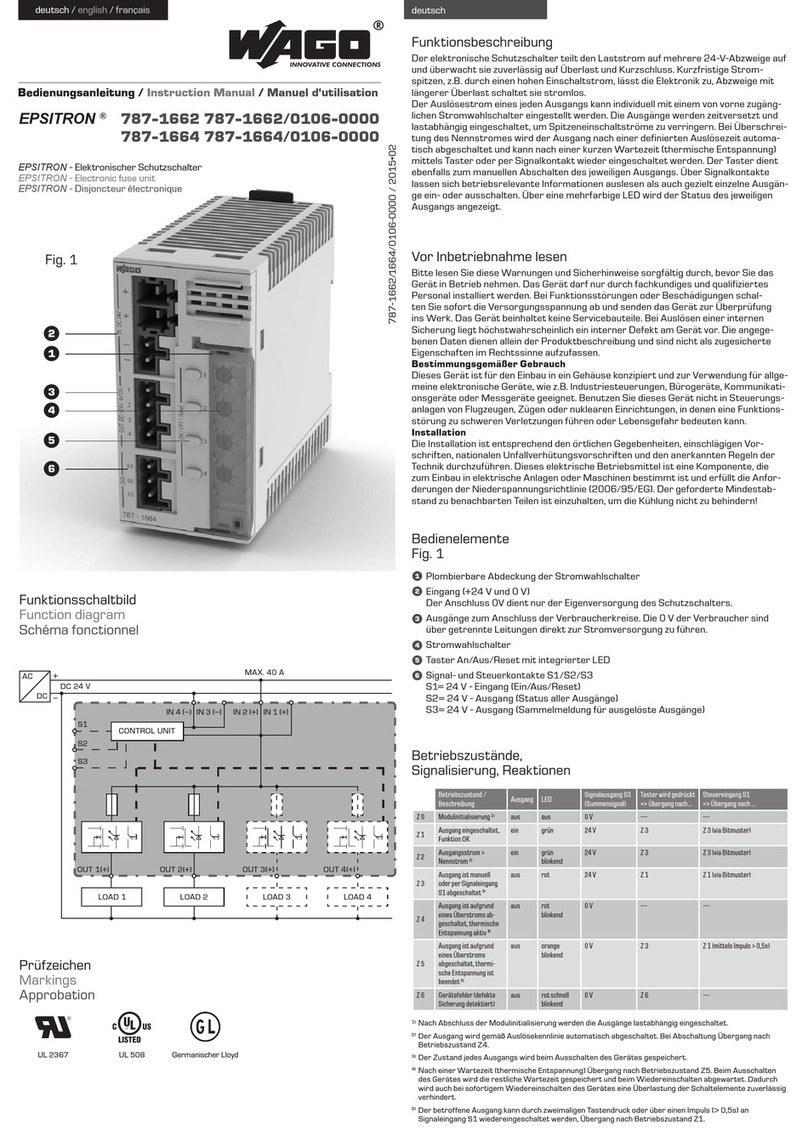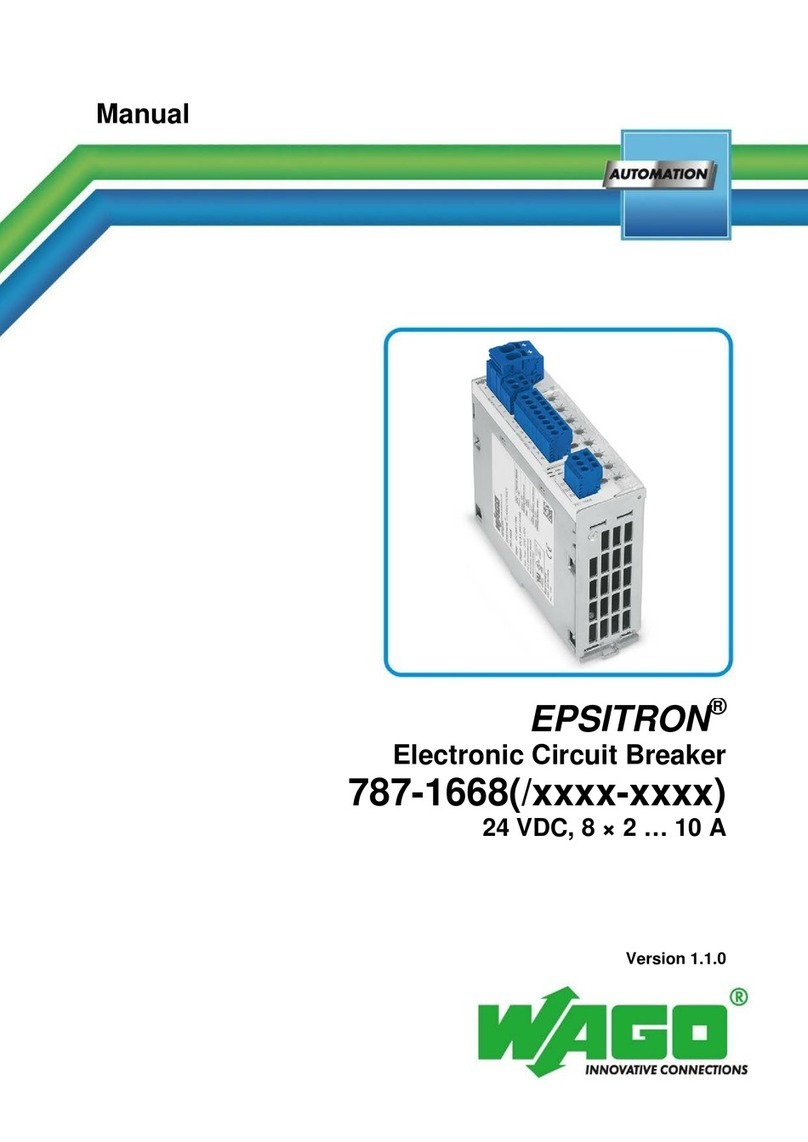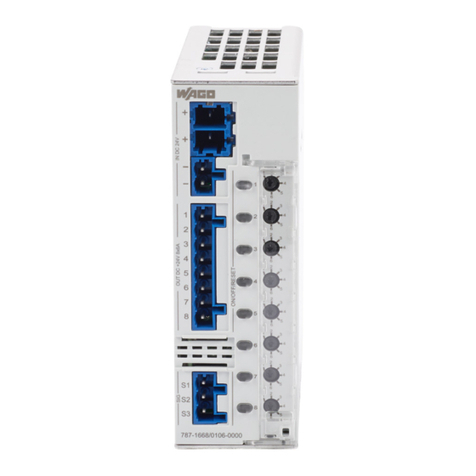
english français
The electronic circuit breaker distributes and monitors the load current over several
current circuits. Overloads and short circuits on an output are reliably recognized.
The electronics permit brief current peaks and switch longer overloads off. The rated
current for each output can be individually set with a current-select or-switch acces-
sible from the front. The outputs are time-delay and load-depend activated to avoid
overload current.
If the rated current is exceeded for a cert ain time, the output will be swit ched of f au-
tomatically and can be switched on after a waiting time (thermal relaxation) using the
pushbutton or the remote signal-input S1. The pushbutton can also be used to switch
the output manually. It is possible to read out the state of each output using the three
signal contact s. The state of each output is also indicated with a multi-colored LED.
Product Description
Le disjoncteur électronique permet la distribution du courant de charge sur plusieurs
sorties 24 V CC et les contrôle fiablement en cas de surchage ou court-circuit. La
protection électronique autorise des pics de courant tel qu’un courant d’appel élevé au
démarrage. Elle se désactivera en cas de charges plus longues.
Le courant de déclenchement de chacune des sorties peut être paramétré
individuellement via les sélecteurs situés à l’avant de l’appareil. Les sorties sont
activées avec un décalage en tenant compte des charges afin d’éviter les pics de
courant. En cas de dépassement du courant nominal, la sortie sera automatiquement
désactivée après un délai de déclenchement défini et pourra après un bref temps
d’attente (détente thermique) être réactivée à l’aide du bouton ou de l‘entrée de
commande S1. Le bouton sert aussi pour la désactivation manuelle des sorties
respectives. Il est possible de visualiser les états de fonctionnement via les sorties de
signalisation, ainsi que d’activer ou désactiver individuellement les sorties. L’état des
sorties sera indiqué individuellement par une LED multicolore.
Fonctionnement général
Before operating this unit please read the manual thoroughly. This device may only be
installed and put into operation by qualified personnel. If damage or malfunction should
occur during operation, immediately turn power off and send unit to the factory for
inspection. The unit does not contain serviceable parts. The tripping of an internal fuse
is caused by an internal defect.
The information presented in this document is believed to be accurate and reliable and
may change without notice.
Intendend Use
This device is designed for installation in an enclosure and is intended for general use
such as in industrial control, office, communication, and instrumentation equipment.
Do not use this device in aircraft, trains and nuclear equipment where malfunction may
cause severe personal injury or threaten human life
Installation
Installation must be carried out according to the prevailing local conditions and safety
regulations, national accident prevention regulations and the generally accepted rules
of technology. This equipment is a component designed for installation into electrical
systems and machines, and fulfills the requirements of the low voltage guidelines
(2014/35/EU). The required minimum spacing to neighboring components must be
observed to guarant ee the required cooling!
Read this first
Veuillez lire soigneusement ces avertissements et consignes de sécurité avant de
mettre l’appareil en service. L’appareil ne doit être installé que par du personnel
compétent et qualifié. En cas de dysfonctionnement, couper immédiatement la tension
d’alimentation et retourner l’appareil à l’usine pour vérification. L’appareil ne contient
pas de pièces échangeables. En cas de déclenchement d’un fusible interne, l’appareil
présente vraisemblablement un défaut. Les données indiquées sont à but descriptif.
Elles ne doivent pas être interprétées comme des caractéristiques assurées au sens
juridique du terme.
Usage conforme
Cet appareil est conçu pour être installé en armoire et convient à une utilisation sur
des installations électriques générales telles que des commandes industrielles, des
appareils de bureau, de communication ou de mesure. Ne pas utiliser cet appareil à
bord des commandes d’avions, de trains, ou installations nucléaires, dans lesquelles un
dysfonctionnement peut entrainer des blessures graves ou signifier un risque mor tel
Installation
L’installation doit être réalisée conformément aux recommandations locales, aux
directives nationales relatives à la prévention des accidents ainsi que les normes
techniques reconnues. Cet équipement est un composant destiné à un montage
sur des systèmes et des machines électriques. Il est conforme aux conditions de la
Directive Basse tension (2014/35/EU). La distance minimale requise avec les modules
avoisinants doit être respectée afin de ne pas entraver le refroidissement.
A lire avant la mise en service
1
2
3
4
5
6
Sealed cover of the current-selector-switches
Input (+24 Vdc and 0 Vdc)
The 0 Vdc connection of the device merely serves to supply the internal electronic
circuits.
Outputs for connecting the load circuits. The 0 V of the loads must be supplied
directly to the power supply by means of separate lines.
Current-selector-switches
Pushbuttons On/O ff/Reset with int egrated LED
Signaling contacts S1/S2/S3
S1= 0 Vdc - input (On/Off/Reset) 1)
S2= open - output (status output channels) 2)
S3= open - output (common message for tripped or switched off outputs) 2)
User elements
Fig. 1
1
2
3
4
5
6
Capot de protection des sélecteurs
Entrée (+24 V CC et 0 V CC).
La connexion du 0 V CC est utilisée uniquement pour l‘alimentation du disjoncteur
Sor ties pour le raccordement des charges. Le 0 V CC des charges doit être
raccordé directement à l‘alimentation électrique par des câbles séparés.
Sélecteur
Bouton marche/ arrêt / réinitialisation avec LED intégrée
Commande S1 et sorties de signalisation S2/S3
S1 =0 V CC - Entrée (Marche/arrêt/ Réinitialisation) 1)
S2= ouvert - Sortie (indique l’état de fonctionnement de toutes les sorties) 2)
S3= ouvert - Sortie (alarme collectif pour sorties déclenchées ou désactivées) 2)
Eléments de commande
Fig. 1
Operating states,
Signaling, Reactions
Etats de fonctionnement,
signalisation, réactions
1) With inver t ed logic (0Vdc ≙ High, 24Vdc ≙ Low)
2) The outputs S2 and S3 ar e negati ve swi tching outputs (Open-Drain).
The inpu ts pull down the applied pot ential S2 and S3 against the negati ve pot ential .
1) Avec une logique inversée (0 V CC ≙ High, 24 V CC ≙ Low)
2) Les sorties S2 et S3 sont de s sor t ies de commutation nega tives (Drain ouver t ).
Les entrées dessinent le potentiel appliqué S2 et S3 par rapport au potentiel négatif.
1) After the initialization of the device the outputs are switched on (load dependent).
2) The output is automatically deactivated in accordance with tripping-curves-characteristics.
3) The state is saved at power - of f of all output s.
4) After a specific time interval (Thermal relief) change to operational condition Z5. If the unit is switched off
the remaining time is saved and will resume with the next switch on. This reliably prevents overloading if the
uni t is immediately switched back on.
5) The affected output can be reset by pressing the push button twice or through an impulse (>0,5s) on signal
input S1. Change to operational condition Z1.
1) Une fois le module initialisé, les sorties seront activées dépendamment de la charge.
2) La sor tie est désact ivée aut omat iq uement conformément à la carac téristique de déc lenchement
3) L’é tat de fonctionnement de chaque sor tie est enr egistré à la coupure de l’appar eil.
4) Après un délai d’attente (détente thermique), la sortie peut être réactivée. Le temps d’attente restant est
enr egis tré lors de la coupur e de l’appareil et son expiration se fera au redémarrage.
5) La sortie concernée peut être réinitialisée en pressant 2 X sur le bouton ou via une impulsion (>0.5 s) sur la
l‘entrée de commande S1 , passage à l‘état Z1.
State / Description Output LED Signal output S3
(Summation)
Pushbutton pressed
=> go to...
Signal input S1
=> go to...
Z 0 Initialization 1) off off open --- ---
Z 1 Output on, function OK on green 0 Vdc Z 3 Z 3 (via bit-streaming)
Z 2 Output current > rated
current 2)
on green
flashing
0 Vdc Z 3 Z 3 (via bit-streaming)
Z 3
Output was switched
off manually or through
signal input S1 3)
off red open Z 1 Z 1 (via bit-streaming)
Z 4
Output was switched
off automatically (over
current), thermal
relaxation active 4)
off red
flashing
open --- ---
Z 5
Output was switched
off automatically (over
current), thermal
relaxation finished 5)
off orange
flashing
open Z 3 Z 1 (through impulse > 0,5 s)
Z 6 Output malfunction
(internal fuse blown)
off red flasing
fast
open Z 6 ---
Etat de fonctionnement /
Description Sortie LED Sor tie de signal S3
Message collectif
Bouton est actionné
=> aller à...
Entrée de commande S1
=> aller à...
Z 0 Initialisation de module 1) arrêt arrêt ouvert --- ---
Z 1 Sortie activée, Fonction OK marche vert 0 V CC Z 3 Z 3 (via configuration
binaire)
Z 2 Courant de sortie > Courant
nominal 2)
arrêt clignote
vert
0 V CC Z 3 Z 3 (via configuration
binaire)
Z 3
La sortie est déactivée
manuellement ou par l‘entrée de
signal S1 3)
arrêt rouge ouvert Z 1 Z 1 (via configuration
binaire)
Z 4
La sortie est désactivée en raison
d‘un courant de surcharge,
détente thermique active 4)
arrêt clignote
rouge
ouvert --- ---
Z 5
La sort ie est désactivée en raison
d‘un courant de surcharge,
la détente thermique est terminée 5)
arrêt clignote-
orange
ouvert Z 3 Z 1 (par impulsion
>0,5 s)
Z 6
Erreur de l‘appareil (fusible interne
défectueux détecté)
arrêt clignote
rapidement
rouge
ouvert Z 6 ---


























